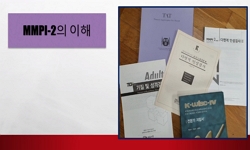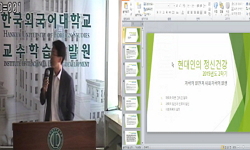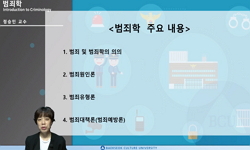The purpose of this study is to investigate whether the factors from the Five-Factor Model of Personality can be applied to a categorical model of personality disorders. Three hundred ninety subjects, who were over 19 years of age, participated in col...
http://chineseinput.net/에서 pinyin(병음)방식으로 중국어를 변환할 수 있습니다.
변환된 중국어를 복사하여 사용하시면 됩니다.
- 中文 을 입력하시려면 zhongwen을 입력하시고 space를누르시면됩니다.
- 北京 을 입력하시려면 beijing을 입력하시고 space를 누르시면 됩니다.

DSM-Ⅳ 성격장애와 성격 5요인 간의 관계 = The Relationships between DSM-IV Personality Disorders and the Five Factors of Personality
한글로보기https://www.riss.kr/link?id=A104696598
- 저자
- 발행기관
- 학술지명
- 권호사항
-
발행연도
2008
-
작성언어
Korean
- 주제어
-
등재정보
KCI등재
-
자료형태
학술저널
- 발행기관 URL
-
수록면
777-787(11쪽)
-
KCI 피인용횟수
12
- DOI식별코드
- 제공처
- 소장기관
-
0
상세조회 -
0
다운로드
부가정보
다국어 초록 (Multilingual Abstract)
The purpose of this study is to investigate whether the factors from the Five-Factor Model of Personality can be applied to a categorical model of personality disorders. Three hundred ninety subjects, who were over 19 years of age, participated in collecting the data. The five factors (neuroticism, extroversions, openness to experience, agreeableness, conscientiousness) of personality showed significantly correlations with the scores of the ten DSM-Ⅳpersonality disorders. On the results of multiple regression analysis, the five factors of personality significantly predicted the DSM-IV personality disorders. The Paranoid, Schizotypal, Borderline, Avoidant, and Dependant PDs were positively predicted by ‘neuroticism’. The Paranoid, Schizoid, Avoidant, and Obsessive-Compulsive PDs were negatively predicted and the Borderline PD was positively predicted by ‘extroversion’. The Schizotypal, Borderline, and Narcissistic PDs were positively predicted by ‘openness to experience’. The Paranoid, Schizotypal, Antisocial, Borderline, Histrionic, and Narcissistic PDs were negatively predicted by ‘agreeableness’. The Paranoid and Obsessive-Compulsive PDs were positively predicted and the Histrionic and Narcissistic PDs were negatively predicted by ‘conscientiousness’. These results suggest that personality disorders can be represented by the Five-Factor Model of Personality.
참고문헌 (Reference)
1 서재삼, "한국형 성격장애 진단검사의 개발과 타당화" 한국임상심리학회 25 (25): 273-288, 2006
2 황순택, "전형성 평정에 의한 성격장애 진단준거 개발" 연세대 대학원 1995
3 Lynam, D. R., "Using the Five-Factor Model to represent the DSM-IV personality disorders: An expert consensus approach" 110 : 401-412, 2001
4 Blais, M. A., "Toward an emprical/theoretical grouping of the DSM-III-R personality disorders" 11 : 191-198, 1997
5 Widiger, T. A., "Toward a dimensional model for the personality disorders in Personality disorders and the five-factor model of personality" American Psychiatric Associa 19-39, 1994
6 Goldberg, L. R., "The structure of phenotypic personality traits" 48 : 26-34, 1993
7 Saulsman, L. M., "The five-factor model and personality disorder. empirical literature: a meta-analytic review" 23 : 1055-1085, 2004
8 Blashfield, R. K., "The classification of psychopathology" Plenum 1984
9 Lehne, G. K., "The NEO-PI and the MCMI in the forensic evaluation of sex offenders in Personality Disorders and the Five-Factor Model of Personality" American Psychological Association 1994
10 Widiger, T. A., "The DSM-III-R Categorical Personality Disorder Diagnoses: A Critique and a Alternative" 4 : 75-90, 1993
1 서재삼, "한국형 성격장애 진단검사의 개발과 타당화" 한국임상심리학회 25 (25): 273-288, 2006
2 황순택, "전형성 평정에 의한 성격장애 진단준거 개발" 연세대 대학원 1995
3 Lynam, D. R., "Using the Five-Factor Model to represent the DSM-IV personality disorders: An expert consensus approach" 110 : 401-412, 2001
4 Blais, M. A., "Toward an emprical/theoretical grouping of the DSM-III-R personality disorders" 11 : 191-198, 1997
5 Widiger, T. A., "Toward a dimensional model for the personality disorders in Personality disorders and the five-factor model of personality" American Psychiatric Associa 19-39, 1994
6 Goldberg, L. R., "The structure of phenotypic personality traits" 48 : 26-34, 1993
7 Saulsman, L. M., "The five-factor model and personality disorder. empirical literature: a meta-analytic review" 23 : 1055-1085, 2004
8 Blashfield, R. K., "The classification of psychopathology" Plenum 1984
9 Lehne, G. K., "The NEO-PI and the MCMI in the forensic evaluation of sex offenders in Personality Disorders and the Five-Factor Model of Personality" American Psychological Association 1994
10 Widiger, T. A., "The DSM-III-R Categorical Personality Disorder Diagnoses: A Critique and a Alternative" 4 : 75-90, 1993
11 Dyce, J. A., "The Big Five factors of personality and their relationship to personality disorders" 53 : 587-593, 1997
12 Trull, T. J., "Structured interview for the five-factor model of personality" Psychological Assesment Resources 1997
13 Soldz, S., "Representation of personality disorder in circumplex and five factor space L Exploration with a clinical sample" 5 : 41-52, 1993
14 Hyer, L., "Relationship of NEO-PI to personality styles and severity of trauma in chronic PTSD victims" 50 : 699-707, 1994
15 Tyrer, P., "Problems in the classi-. fication of personality disorder" 17 : 15-20, 1987
16 Digman, J. M., "Personality structure: Emergence of the five-factor model" 41 : 417-440, 1990
17 Costa, P. T. Jr., "Personality disorders and the five-factor model of personality" 4 : 362-371, 1990
18 Dyce, J. A., "Personality disorders and the five-. factor model: A test of facet-level predictions" 12 : 31-45, 1998
19 Yang, J., "Personality disorders and the Five-Factor Model of personality in Chinese psychiatric patients in Personality disorders and t"
20 Widiger, T. A., "Personality disorder dimensional models proposed for DSM-IV" 5 : 386-398, 1991
21 Coolidge, F. L., "On the relationship of the five-factor personality model to personality disorders: Four reservations" 75 : 11-21, 1994
22 안창규, "NEO-PI-R의 한국표준화를 위한 연구" 9 : 443-473, 1997
23 민병모, "NEO 인성검사" PSI 컨설팅 1997
24 Goldberg, L. R., "Language and individual differences: The search for universals in personality lexicons" 2 : 141-165, 1981
25 Widiger, T. A., "Five-factor model assessment of. personality disorder" 89 : 16-29, 2007
26 Widiger, A. T., "Five factor model of personality disorder: Integrating science and practice" 39 : 67-83, 2005
27 Costa, P. T. Jr., "Facet scales for agreeableness and conscientiousness: A revision of the NEO Personality Inventory" 12 : 887-898, 1991
28 Haigler, E. D., "Experimental manipulation of NEO PI-R items" 77 : 339-358, 2001
29 Morey, L. C., "Dimensions and categories: The “big five” factors and the DSM personality disorders" 7 : 203-216, 2000
30 American Psychiatric Association, "Diagnostic and statistical manual of mental disorders" 1994
31 American Psychiatric Association, "Diagnostic and statistical manual of mental disorders" 1980
32 Widiger, T. A., "Diagnostic Categories or Dimensions? A Question for the Diagnostic and Statistical Manual of Mental Disorders Fifth Edition" 114 : 494-504, 2005
33 Bagby, R. M., "DSM-IV Personality Disorders and the Five-Factor Model of Personality: A Multi-Method Examination of Domain- and Facet-Level Predictions" European Journal of Personalit 2005
34 Trull, T. J., "DSM-III-R Personality disorders and the five-factor model of personality: an empirical comparison" 101 : 553-560, 1992
35 Oldham, J. M., "DSM-III personality disorders: Assessment problems" 1 : 241-247, 1987
36 Widiger, T. A., "Clinician's Judgments of Clinical Utility: A Comparison of the DSM-IV and Five-Factor Models" 115 : 298-308, 2005
37 Blais, M. A., "Clinical ratings of the five-factor model of personality and the DSM-IV personality disorders" 185 : 388-393, 1997
38 Millon, T., "Classification in psychopathology: Rationale, alternatives, and standards" 100 : 245-261, 1991
39 Frances, A. J., "Categorical and dimensional systems of personality diagnosis: A comparison" 23 : 506-526, 1982
40 Eysenck, H., "A critique of contemporary classification and diagnosis in Contemporary directions in psychopathology: Toward the DSM-IV" Guilford Press 73-98, 1986
동일학술지(권/호) 다른 논문
-
자기초점주의가 자전기억의 과일반화와 우울에 미치는 효과: 자기초점주의의 적응성과 부적응성
- 한국임상심리학회
- 이인혜
- 2008
- KCI등재
-
어머니의 양육태도가 청소년 우울에 미치는 영향: 회피적 정서조절과 정서인식의 명확성을 매개요인으로
- 한국임상심리학회
- 양유진
- 2008
- KCI등재
-
5·18 피해자들의 생활스트레스, 대처방식, 지각된 사회적 지지와 외상후 스트레스, 심리건강 간 관계
- 한국임상심리학회
- 오수성
- 2008
- KCI등재
-
한국판 부모 양육스트레스 검사(Korean-Parenting Stress Index: K-PSI)의 표준화 연구
- 한국임상심리학회
- 정경미
- 2008
- KCI등재
분석정보
인용정보 인용지수 설명보기
학술지 이력
| 연월일 | 이력구분 | 이력상세 | 등재구분 |
|---|---|---|---|
| 2026 | 평가예정 | 재인증평가 신청대상 (재인증) | |
| 2020-01-01 | 평가 | 등재학술지 유지 (재인증) |  |
| 2017-01-01 | 평가 | 등재학술지 유지 (계속평가) |  |
| 2016-03-22 | 학술지명변경 | 한글명 : 한국심리학회지 임상 -> Korean Journal of Clinical Psychology |  |
| 2016-02-16 | 학술지명변경 | 외국어명 : The Korean Journal of Clinical Psychology -> Korean Journal of Clinical Psychology |  |
| 2014-04-10 | 학회명변경 | 영문명 : The Korean Society Of Clinical Psychology -> Korean Clinical Psychology Association |  |
| 2013-01-01 | 평가 | 등재학술지 유지 (등재유지) |  |
| 2010-01-01 | 평가 | 등재학술지 유지 (등재유지) |  |
| 2008-01-01 | 평가 | 등재학술지 유지 (등재유지) |  |
| 2006-01-01 | 평가 | 등재학술지 유지 (등재유지) |  |
| 2005-01-27 | 학회명변경 | 한글명 : 한국심리학회 산하 임상심리학회 -> 한국임상심리학회 |  |
| 2004-01-01 | 평가 | 등재학술지 유지 (등재유지) |  |
| 2001-01-01 | 평가 | 등재학술지 선정 (등재후보2차) |  |
| 1998-01-01 | 평가 | 등재후보학술지 선정 (신규평가) |  |
학술지 인용정보
| 기준연도 | WOS-KCI 통합IF(2년) | KCIF(2년) | KCIF(3년) |
|---|---|---|---|
| 2016 | 1.36 | 1.36 | 1.6 |
| KCIF(4년) | KCIF(5년) | 중심성지수(3년) | 즉시성지수 |
| 1.69 | 1.77 | 2.966 | 0.3 |





 KCI
KCI






